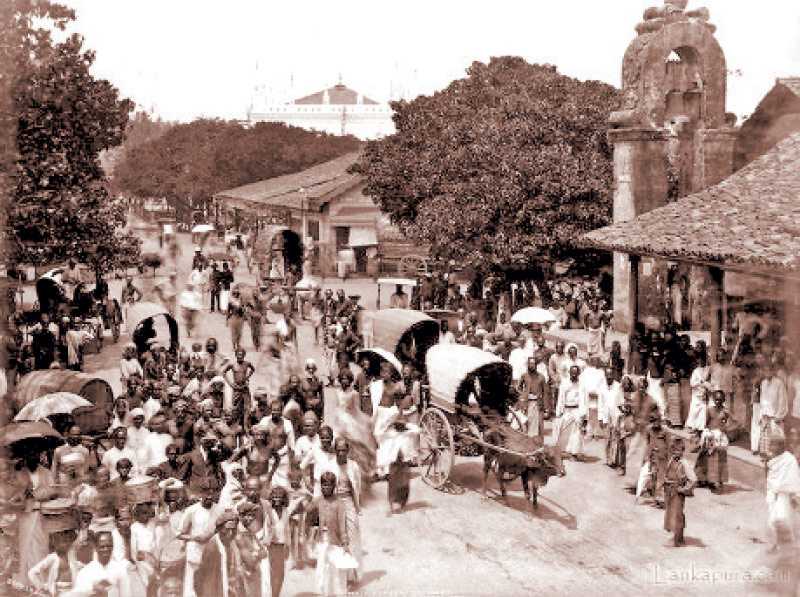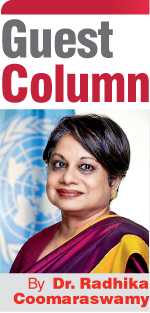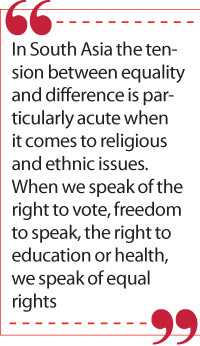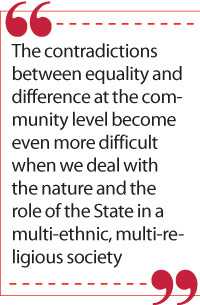Monday Apr 07, 2025
Monday Apr 07, 2025
Monday, 4 January 2021 00:00 - - {{hitsCtrl.values.hits}}

In Sri Lanka, the Muslims had their own law, the Kandyan Sinhalese their own law and the Tamils had their own. These laws determined the nature of marriage, divorce and the sharing of property and inheritance. Because of the nature of the social compact and understanding it continued after independence and is basically intact even today
 This article will argue that there is a tension between ‘equality’ and ‘difference’ in modern South Asia. That tension defines South Asia and is reflected in issues related to religion and ethnicity. It is manifested at individual, community and state level. In the near future, because of the pandemic, this tension may be over-determined by economic hardship and economic inequality, leading to unintended consequences
This article will argue that there is a tension between ‘equality’ and ‘difference’ in modern South Asia. That tension defines South Asia and is reflected in issues related to religion and ethnicity. It is manifested at individual, community and state level. In the near future, because of the pandemic, this tension may be over-determined by economic hardship and economic inequality, leading to unintended consequences
The fight for equality was the primary theme of the 20th century as freedom was in the century before. People struggled for equality among classes, races, religions, castes and genders. They fought for it within the framework of apartheid, within the framework of gender struggles as well as striving for Dalit rights in India.
Equality was called for, not only on the face of the law but also in application and implementation. One country one law, a new political cry in South Asia, is from one vantage viewpoint the culmination of that struggle. As Aristotle conceptualised in earlier centuries, equality must mean that everybody – who in his eyes was a citizen – is treated the same.
While people fought for equality they also strived for modern societies to recognise and celebrate difference. It was the era of identity politics. Under the rubric of freedom of association, freedom of religion and freedom of expression they expected their states and societies to accept diversity, dissent, alternative lifestyles and ways of being.
People wanted to be French and also wear the headscarf, or be Canadian and also live on Indian lands with their own laws and heritage. They struggled for this recognition. They wanted their State and society to accept and tolerate their distinctiveness. The richness of modern life, especially in the cultural sphere, is due to this openness to embrace difference. Pluralism is the political and cultural doctrine that embodies this notion of accepting difference as policy and a tolerant way of life. 
Religion and ethnicity
In South Asia the tension between equality and difference is particularly acute when it comes to religious and ethnic issues. When we speak of the right to vote, freedom to speak, the right to education or health, we speak of equal rights.
We are all the same. When we think of our religion and our ethnic community we experience and value our difference. To understand the tension we must also understand the religious, cultural experience.
W was a Hindu by birth. Her father loved her, protected her and educated her. Her mother was her source of energy. These were colonial times and M was boarded at a leading Catholic school. She loved the school and she had friends from every community and every faith. They all spoke and wrote in English.
Despite the diversity, she grew into a young adult imbibing Christian values and with it a British way of life. Every day in school she sat in the last row of the chapel because she felt she did not belong but she prayed hard. She felt the presence of the sacred. When she was at home with her extended Hindu family she was fully involved in the rituals and practices and she watched these practices change over time.
As a young girl when she menstruated she was sent to the outhouse till her menses was over. By the time she was a mother, these practices had changed for her family. Christian and colonial unease with many of these practices challenged the local religious elites. Christianity was the gold standard and all religions had to conform to some of its values to compete and to stand their ground.
W’s grandniece who lived all her life in Sri Lanka would grow up in a different world. Her friends were primarily Tamil. The British had left Sri Lanka and the grandniece was brought up in a Hinduism deeply influenced by Arumugha Navalar.
Navalar was a Hindu revivalist trained by Christian missionaries. He then turned against them, reviving Hinduism in Jaffna and Chennai. He helped Percival translate the Bible into Tamil and then made his own journey at about the same time that Anagarika Dharmapala and the Theosophists were re-discovering Buddhism.
He embedded his own ‘Saiva Siddanta’ teachings, a Tamil Hindu catechism of sorts and other practices through his network of schools and lay gatherings. This was a conservative Hinduism that brought narrowness, rigidity and structure to a culture that was once more diverse and plural. Modelled on the Christian missionary tradition it gave a sense of identity and purpose to many Tamils. By the 1980s it was the main religious way of “being Tamil” in Sri Lanka.
W’s daughter would travel the world and her connection to Hinduism would be less intense. Orthodoxy, its exclusivity and narrowness did not inspire her. She developed a cosmopolitan spirituality that celebrates the heterodox traditions within established religions that asserted the commonality of the human experience.
For her, spirituality and artistic expression were also linked and God was present in many works of literature, music and art. Like many young people exposed to diverse cultures, spirituality was experienced as an overwhelming force that makes you at home in sacred places of worship of all faiths. It also enfolds you in the beauty of nature and the works of the human imagination. Pluralism comes naturally to such a consciousness. It is restless in any other framework.
Religion is then an intensely personal experience for many and its manifestation may change with every generation. It is a way of coping with the vicissitudes of life and the uncertainty that living brings. It brings solace and transcendence. It is when religious experience moves from the personal to the community level that it changes its character.
For most South Asians religion is primarily experienced at the community level. The community, often built around the temple, church or mosque, is life affirming for many people. It inspires cultural life, it provides a space for meeting and spending time with people, it takes care of you when in need, it fosters charities and it protects you in times of difficulty.
Without this religious community there would be no social life for most people in South Asia. But this sense of community is not always a positive experience. Many women have broken free of its rigid gender hierarchies. Sociologists and anthropologists have written how this religious community inspires and deadens at the same time, how it brings out the best in us while its space is often used to spew out the worst forms of hatred and intolerance. Religion in South Asia is transcendence. It is also the vitriol.
One way religious and ethnic differences manifest themselves in South Asia is through the system of what is called ‘personal laws’. Partha Chatterjee has often written about what he calls the colonial compromise. During colonial times, it was understood that public life, the State and economic institutions would be modelled along the lines of modern democracy and capitalism.
Different forms of law in the country
Parliament and the Central Bank were accepted and modelled on the west. But, private and community life was left to the local communities themselves. Their family law, rituals and practices for the most part would continue.
Women would play a major role in maintaining that identity – the clothes, the rituals, the holidays and the relationship to religious associations and organisations. This colonial compromise allowed South Asians to be part of both the modern and pre modern world at the same time.
The colonial compromise has been challenged from both sides. Women’s groups from all over the world have asked that this private public distinction be removed and there be a modern human rights friendly law and culture for all. On the other side, there are cultural nationalists who want to wipe out our colonial heritage, asking what they see as hypocrisy to be removed. They feel that Sri Lankan and Indian models from the past should guide our politics and economics.
Family law has been left to the respective communities for many centuries. The Dutch and the British codified the existing practice, inventing certain provisions as they went along, leaving behind a framework of personal laws.
In Sri Lanka, the Muslims had their own law, the Kandyan Sinhalese their own law and the Tamils had their own. These laws determined the nature of marriage, divorce and the sharing of property and inheritance. Because of the nature of the social compact and understanding it continued after independence and is basically intact even today.
With the rise of the women’s movement these laws came into greater focus. Many of these laws, some with origins in religious interpretation, had unconscionable provisions with regard to women; child marriage, no consent at time of marriage, polygamy, unilateral divorce, denial of child custody, lack of maintenance and unequal inheritance.
One of the early calls for personal law reform came from the Indian women’s movement until they were blindsided when the call was taken up by extreme majoritarian groups that called for “one nation, one law” that aimed at obliterating the identity of the minorities. In India, women’s rights then became the justification for denial of ethnic and religious identity markers.
Which brings us back to the question of equality and difference. One could argue that equality requires one nation, one law and that all women be treated alike. Difference requires respecting the identity of different communities, their personal laws and allowing certain autonomy for them to give expression to their identity. How does one manage that tension between equality and difference?
Equality and difference
Until extreme groups took up the battle cry on either side of this issue, many suggestions had been put forward. Firstly there was the suggestion of optionality. Couples on their wedding day had the option of choosing which law should govern their private lives, the general law or the personal law. The second suggestion was that a minimum core based on human rights be formulated such as in South Africa and its policy toward tribal customary laws.
There are certain provisions that must be present to protect women and children. These usually revolve around the issue of a woman’s consent and the economic protection of women and children. Any personal law must meet these basic minimum requirements of human rights.
People have been discussing these issues for years. In Sri Lanka today, the heat of the moment makes it difficult to come to a deliberative position where such issues can be resolved through consensus and compromise. The medieval position of some Muslim associations and the current strong and strident movement for “one country, one law” makes it difficult. The tension between equality and difference is not a healthy one.
The contradictions between equality and difference at the community level become even more difficult when we deal with the nature and the role of the State in a multi-ethnic, multi-religious society.
A commitment to equality usually requires an active intervening state structure that provides social protection in the area of health, education and social welfare and also intervenes to ensure the equitable distribution of a country’s resources.
As in most socialist and social democratic societies, the State is involved in most aspects of people’s lives. The Scandinavian states are perhaps the model for states that value equality as one of their organising principles. Needless to say they are homogenous societies.
On the other hand, a State structure that values difference has to be more self-restrained, respecting autonomy and self-growth among the different groups. This is not only with regard to personal law as described above and the performance and observance of religious ritual; it is also about the structure of the state, especially if there are territorially placed minorities.
The Swiss and Canadian State structures are those that make difference an organising principle. It is not a surprise to note that the leading theorists of pluralism such as Charles Taylor come from Canada. For them the individual can only be fully understood in the context of the community he belongs to and the recognition of different identities is a fundamental aspect of Constitutional law.
Indian states that are organised linguistically also accept a pluralistic model although the Constitution ensures that the central Government has strong powers in case any of the states stray too far.
Most of the regimes in South East and East Asia, on the other hand, have little patience with state models that value difference. The emphasis is on a strong developmental state that would impose its will, develop the country and force equality on all its peoples. In defiance of pluralism these states would follow a cultural politics of assimilation and a political project that leaves little room for dissent. Difference in any meaningful form will not be tolerated.
Asia then presents the possibility of two options – a democratic, plural model on the one hand and a centralising, intervening developmental state on the other. Asian policymakers have for the most part chosen the second though there are notable exceptions.
Even in India, the democratic, plural model is today in retreat. But is the so-called Asian model with its powerful national security State sustainable? With time will it not change or evolve into a democratic, plural system like in South Korea and Indonesia?
Given the centralisation of vast amounts of power, a great deal depends on those who run the state apparatus- whether they would give into the temptation of corruption and the abuse of power for personal and political advantage and whether they have the self-restraint to work without external checks and balances.
If they do not have such internal systems, dysfunctional autocratic models will emerge, encouraged by crony capitalism and military interests. In time they will suppress both equality and the respect for difference, though consumer markets may survive.
Democracy and pluralism, despite their chaos, are checks and balances in the State system that try to ensure a political culture of consultation and the sharing of power. They are messy but they ensure a process that makes the system sustainable because they make change possible and routine and its possibility embedded.
They work to a social compact where everyone feels they have a stake. A politics that is based around these conversations and agitation toward consensus building has made an appearance among young people throughout Asia. Perhaps that is a way for the future.
Despite these developments at the macro level, the tension between equality, difference and the role of the state plays out in everyday life on a routine, cantankerous basis. In Sri Lanka, the Government’s refusal to allow Muslims to bury their dead is a case in point. The argument put forward by the Government is supposedly based on science and a fear of infection.
When the whole world except China allows for burial, where the WHO lays out guidelines for such practices and our leading international scientists like Prof. Malik Peiris make clear that the scientific basis is invalid for such a ban, the Government still stands steadfast.
The real reason seems to be the one that is understated. It is articulated under a restrictive theory of equality. Why are the Muslims demanding exceptionalism? Why can’t they submit to the rules of the land and be treated like everyone else? To Muslims, fire is reminiscent of hell and to cremate bodies is to force them into a compulsory purgatory. Respecting that wish once we have made certain that we are safe does not seem a tall order.
Even countries like India and Myanmar with strong religious majorities have recognised and made room for difference, allowing the Muslims to bury the dead. The Indian Supreme Court has ruled in many cases that the right to dignity includes how one’s dead body is treated. Equality is not only qualified by difference but also by dignity.
Economic inequality
Despite these nuances and the need for those who advocate for equality to understand the nature of identity and difference, the future beckons us in a different direction. We may have to set all this aside. We must come together to realise that economic inequality and protecting the environment clearly remain the foremost challenge of the twenty first century.
As we recover from this devastating pandemic that is where our minds should be focused. How do we build a modern, sustainable country where economic growth and economic inequality are dealt with in a meaningful manner? The petty struggles that attempt to keep minorities in their place and that make minorities restive must give way to the far greater issues that are facing us.
Economic inequality
Two of the greatest theorists of modern times, Thomas Piketty and Samuel Moyn have pointed out that economic inequality is increasing with every generation with the possibility of violence and eruption. In a post-pandemic world, it has become the major global fault line.
Samuel Moyn castigates the international human rights movement for downplaying economic inequality thus contributing to make it a hidden issue that is not properly analysed or dealt with. Both Picketty and Moyn have modern day prescriptions on how to deal with these problems.
They may be radical in intent and structure but they focus attention on what is a long overdue problem. In an era of rapacious, crony capitalism spreading in Sri Lanka and around the world, a discussion on economic equality focuses our attention on the necessary priorities.
He appeared dishevelled. It did not come naturally to him. He was obviously used to discipline. But for over three hours in this pandemic birthday party he was asked to run around. It was a small hotel. He had been out of work, stuck at home without income so he was delighted when he was offered the opportunity to make some money. It was a small group, precautions were taken but there was risk but the risk meant nothing to him.
Feeding his family was paramount on his mind. The moment I saw him I felt guilty. People corked bottles of champagne, danced to Tik Tok, sang raucous songs, pushed each other into the swimming pool and when I retired out of exhaustion, they had just begun the baila session. My eyes rarely left the three young men who were the waiters. How did they feel? Unlike normal times, their eyes were not relaxed. They were not happy. There was a hidden anger.
Every day someone on social media or the newspapers conjures up a nightmare economic scenario for Sri Lanka. Whatever the pathway for many Sri Lankans it will be a few years of economic hardship. The nature of our business sector is that some people will get very rich while others will see their standards fall. Some may be on the borderline of survival while others will spend hard earned savings.
I have no doubt we will survive but economic factors will “overdetermine” everything about us, from our everyday life to our foreign relations. Understanding economic inequality, emphasising the social safety net and ensuring a sustainable environment have to be some of the priorities of the next few years. These priorities have to be planned and thought through if we are to emerge as a society that has not only weathered the crisis but also emerged stronger.
In this context of heightened economic crisis, issues of identity and difference may take a backseat – only if the Government and political parties will it to be so. The ethnic, religious fault line is always there for exploitation. This is the toxic sideshow we are forced to witness in every generation. Let us hope terror networks will not set their eyes on Sri Lanka given some of the short-sighted policies.
But the great fear is that if economic hardship persists and there is resistance and unrest, violence may be directed at the minorities. This has happened throughout history in Sri Lanka and in many parts of the world. Pradeep Jeganathan once wrote that some minorities or marginalised groups are constantly living “in anticipation of violence”.
They structure their lives accordingly. It is their organising principle. It is fair to say the Muslims of Sri Lanka are now in that position. We can only hope that all this discussion on religion, equality, difference and the place of minorities will not finally lead to a very dark place. Given the warning our history has given us, this time we have no excuse.
Discover Kapruka, the leading online shopping platform in Sri Lanka, where you can conveniently send Gifts and Flowers to your loved ones for any event including Valentine ’s Day. Explore a wide range of popular Shopping Categories on Kapruka, including Toys, Groceries, Electronics, Birthday Cakes, Fruits, Chocolates, Flower Bouquets, Clothing, Watches, Lingerie, Gift Sets and Jewellery. Also if you’re interested in selling with Kapruka, Partner Central by Kapruka is the best solution to start with. Moreover, through Kapruka Global Shop, you can also enjoy the convenience of purchasing products from renowned platforms like Amazon and eBay and have them delivered to Sri Lanka.
Discover Kapruka, the leading online shopping platform in Sri Lanka, where you can conveniently send Gifts and Flowers to your loved ones for any event including Valentine ’s Day. Explore a wide range of popular Shopping Categories on Kapruka, including Toys, Groceries, Electronics, Birthday Cakes, Fruits, Chocolates, Flower Bouquets, Clothing, Watches, Lingerie, Gift Sets and Jewellery. Also if you’re interested in selling with Kapruka, Partner Central by Kapruka is the best solution to start with. Moreover, through Kapruka Global Shop, you can also enjoy the convenience of purchasing products from renowned platforms like Amazon and eBay and have them delivered to Sri Lanka.